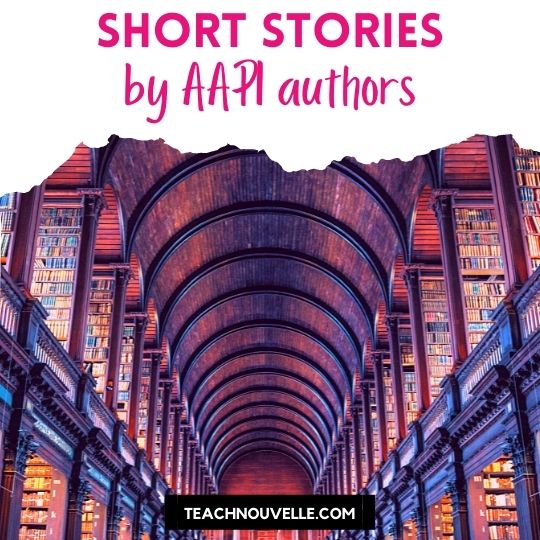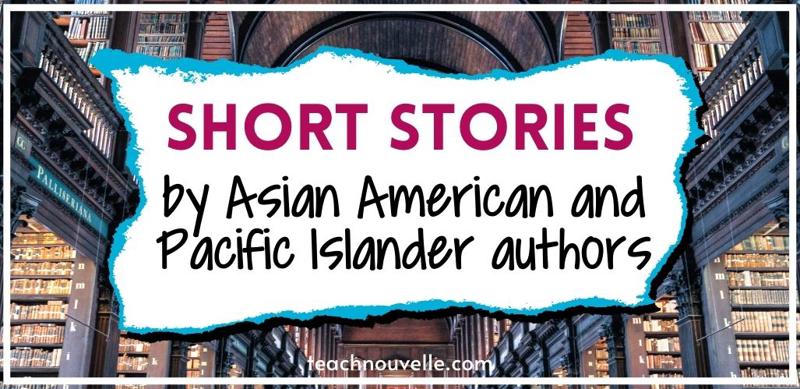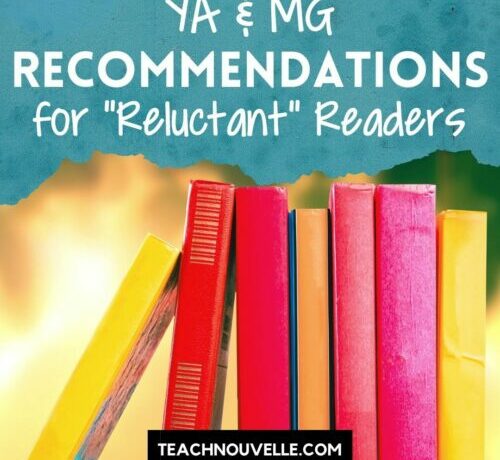May is AAPI Heritage Month, so to celebrate, here are 5 short stories that will help your students connect with and appreciate AAPI cultures.
Danielle here, I’m so happy to share this guest post by Joan Sung, a writer, and educator. Follow her on IG @joansungwriter and check out her cultural competency course aimed to support K-12 educators in better serving Asian American students!
Joan has some great short story recommendations for celebrating AAPI Heritage Month in your classroom, and I have some tips for how to make sure your curriculum is inclusive, year-round. Maybe you’re already working toward creating an inclusive classroom library, here’s a free tool to find any representation gaps in the collection. You can also check out my always-growing, mega list of diverse texts for Secondary ELA.
Okay, that’s enough from me, enjoy Joan’s post:
5 Short Stories to Celebrate AAPI Heritage Month in Secondary ELA
Happy AAPI Heritage Month! If you are looking to incorporate more AAPI authors into your curriculum, you’ve come to the right place. I have curated five of my favorite short stories, highlighting what they bring to the table and a few important things to consider when approaching these diverse stories. By treating these texts with care, we can do more than just inclusion, but also ensure that we do these authors justice while guiding our students through a new cultural perspective.
“Two Kinds” by Amy Tan
“Two Kinds” tells the story of the cultural divide between a traditional Chinese mother and her American-born daughter, Jing-mei Woo. Woo begins learning piano at her mother’s request, and this becomes a source of conflict. As her mother projects her high expectations onto her daughter to become a sort of piano prodigy, Jing-mei questions whether she is living out her own dream or her mother’s. This story is quintessential Amy Tan as she drew from her own experiences with her mother to write this beautiful piece of fiction.
Although Tan wrote the story in 1989, children of immigrants may find this story still hits home. Jing-mei is torn between pleasing her mother and pulling away from her mother for more independence, much to her mother’s displeasure. The idea of children growing to have independence is more of a Western ideal rather than a Chinese one, where it is more uncommon for children to “leave the nest”, which may explain her mother’s resistance. For example, multi-generational households are much more common in East Asia than in America.
Before teaching “Two Kinds”, one might consider teaching about Tiger parenting first so students realize that the mother is not cruel or heartless (which is a cultural misunderstanding). The mother only desires the best for her daughter, which means instilling tenacity in her daughter.
At the end of the story, Jing-mei is an adult and finds herself sitting at her childhood piano once more. She first plays a challenging song titled “Perfectly Contented”, then plays an easier, lighter song titled “Pleading Child”. Only then does she realize that the two songs are actually two halves of the same song. After all this time, Jing-mei had thought that she had to be one or the other: a perfect child or a difficult one. She didn’t realize that you are not one or the other, but that they are one and the same. The pressure she had placed upon herself to be “perfect” was, in fact, not from her mother, but from herself.
“White Umbrella” by Gish Jen
This story opens with a Chinese American girl learning that her mother has to get a job, which is not customary in their culture. (Chinese mothers are not expected to work outside the home).
One day, the little girl attends a piano lesson with her sister and sees another girl at her piano teacher’s house with a white umbrella. The little girl is envious, coveting the white umbrella for herself. She returns for another lesson on a rainy day and is pleased when the umbrella is left behind and the piano teacher gives it to her to keep. After the piano lesson, their mother picks up the little girl and her sister and they get into a car accident. Everyone is safe and the little girl comes to realize what is actually important in life.
A critical step to understanding this seemingly simplistic short story is acknowledging two common themes in immigration stories: poverty and assimilation.
Immigration comes at a high price for some. Many give up everything to offer a better life for their children. Unfortunately, at times their children only want to fit in (i.e. financial security) in order to be accepted as American, at times minimizing their parents’ sacrifice to emigrate from their home country. Although Jen only briefly goes over the mother needing to get a job, this moment is arguably one of the most important parts of the story. The idea of bending your own cultural rules (more sacrifice) in order to survive and start over in a new country. The main character initially rejects the idea of her mother working outside the home because it is not the Chinese way.
Eventually, the reader can see there are parts of “American” life she desires. Even going as far as to say that she wishes the piano teacher was her mother, and wanting materialistic things (as her mother puts it, is very “American”). You may have realized that the main character is contradictory in her wants and desires, but that’s okay! Humans are complicated creatures and we have conflicting perceptions in the way we understand the world and ourselves. The white umbrella symbolizes wealth and assimilation, revealing that what the girl really wants is acceptance without ridicule. The thought of losing her mother in a car crash shifted her recognition of what is truly valuable.
“Hello, my name is_________” by Jason Kim
Jason Kim is a Chinese American actor who was formerly known as Jun Hyuk but changed his name when he immigrated to Missouri. “Hello, my name is ________” is a non-fiction piece that Kim wrote to reflect on his feelings of displacement growing up in the Midwest.
This story starts out being wrought with shame but ends on an inspirational, hopeful note as the author goes from sitting alone on the playground as a child, to the center of attention at his college because of his “diversity”. Kim realizes that what makes you different is what makes you special, but points out that this outcome is still askew.
While Kim embraces his own (and others’) acceptance of his racial identity, he simultaneously points out the irony here that being different is really what ends up getting him attention, but being of a different race should not be so mind-boggling. One day, he hopes for a world where the audience won’t blink an eye when they see an AAPI face on TV, as he wishes he had kept his traditional Korean name when he moved to America.
Before sharing this story, it’s important to help students understand why immigrants commonly choose an “American” name when they immigrate. This is a complex question with complex answers, but the fact that Jason changed his name from Jun Hyuk appears to be one step towards assimilation. Readers need to understand that assimilation can only occur when the person loses a piece of themselves by taking on a new identity. Names have so much significance and they truly are a part of who we are. While some choose new American names to assimilate, others view it as preservation of dignity, avoiding going through a lifetime of people mispronouncing your name.
Something else to touch on is that this story opens up the conversation about the importance of representation and visibility in the media. You could show students the AAPI reception of the film Crazy Rich Asians, for example. I also love Sandra Oh’s Golden Globes acceptance speech, in which she talks about being the first person of AAPI heritage to win the award.
“Fish Cheeks” by Amy Tan
A Chinese American girl is about to have a White American family over for dinner, and the son just so happens to be her crush. When the family arrives and they all sit down for a traditional Chinese dinner, the daughter sees all the offerings on her own dinner table and is appalled at what her mother is serving. It’s important to note that the daughter is looking at the dinner table through what she thinks is the White American eyes, presuming that the dishes look offensive and disgusting. Only after the dinner, when the guests leave, does the mother reveal that she had made her daughter all of her favorite dishes.
Here we have another tale of assimilation and the rejection of one’s own heritage, which is rooted in the fear of experiencing rejection. You can teach the students the concept of the Perpetual Foreigner and why those in the AAPI community react with fear when feeling exposed for being different. I have also taught this short story side-by-side with the short film Bao to highlight the significance of food (a mother’s love) and that rejecting one’s Asian heritage is only to reject a mother’s love.
We also have a characterization analysis activity for this short story, which is a part of our figurative language short story analysis bundle! You can find the “Fish Cheeks” activity for FREE exclusively at our featured blog post HERE!
(Note from Danielle: Short films are great teaching tools, check out this post for more recommendations. I also feature “Fish Cheeks” in this post, 5 Short Texts for Teaching Characterization)
“The All-American Slurp” by Lensey Namioka
In “The All-American Slurp”, Namioka does a fantastic job using food as the primary vehicle to highlight cultural differences between Chinese and American culture. Namioka tells the story of a Chinese American girl who finds herself constantly embarrassed by the way her family cannot seem to grasp American dining customs. However, when her family invites a White American family over for a traditional Chinese dinner, the girl is in for a surprise. It turns out that her family is not the only one who has experienced feeling awkward or displaced.
The story really highlights the protagonist’s feelings of shame. Shame because she feels the pressure to conform, which is stemming from her own fear of rejection. Namioka also emphasizes the little girl’s feeling of relief that all families of different backgrounds can relate to one another. Feeling like an outsider or not fitting in with your surroundings is a universal anxiety. This short story is a good entry-level text to introduce students to the idea of being fearful of being seen as an outsider. You could teach this text first, then follow up with Amy Tan’s “Fish Cheeks”, which is a more challenging text.
Conclusion
Diversifying your curriculum is no simple task. Especially when you are using texts from cultures in which you are unfamiliar. My best piece of advice is to spend the time researching the culture of the author before you approach any text in the classroom. There are many nuances that go with teaching a diverse perspective. Teaching a text written by an AAPI author and asking how their culture affects their identity or actions would fall flat if the teacher did not also understand the culture themselves. I cannot emphasize enough the need to have a basic understanding of an author’s heritage before you begin. It will make it easier for you to guide your students through these complex texts.
Lastly, don’t forget to remind students that being AAPI is not always wrought with trauma and pain. Before you even begin your AAPI unit or text, you could have students watch Chimamanda Ngozi Adichie’s TED Talk, “Danger of a Single Story” to remind kids that one side of a story does not make the entire person or experience. (Danielle here, you can find that TED Talk and more in this post about TED Talks you can use in ELA.)
When we talk about common themes among immigration stories such as fear or rejection, that is not the limit to what it means to be AAPI. There is an incredible amount of joy and pride in having AAPI heritage. Being human is to have multi-faceted types of experiences and the sum of these is what makes us who we are!
Joan King is a United States Air Force veteran, a Korean American daughter of immigrants, and a former English teacher. She lives in the Seattle, Washington area with her two dogs, son, and husband. Find more of her work on JoanSungWriter.com, or follow her on IG @joansungwriter.






